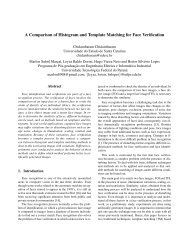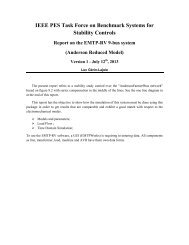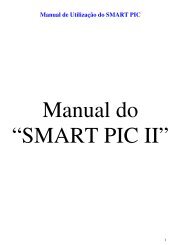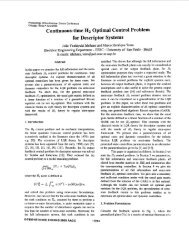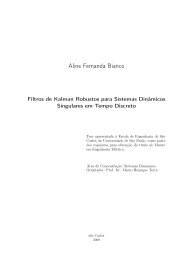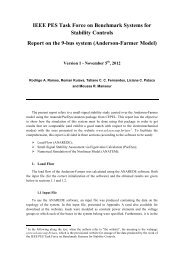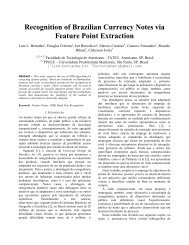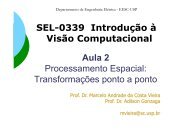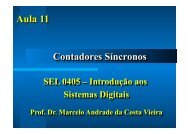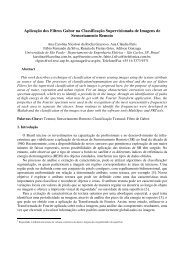<strong>WVC</strong>'<strong>2007</strong> - <strong>III</strong> Workshop de Visão Computacional, 22 a 24 de Outu<strong>br</strong>o de <strong>2007</strong>, São José do Rio Preto, SP.Improving the Richardson-Lucy Algorithm in Deconvolution Micro<strong>sc</strong>opyThrough Poisson Noise ReductionHomem, M. R. P.; Zorzan, M. R.; Ma<strong>sc</strong>arenhas, N. D. A.Universidade Federal de São Carlos, Departamento de ComputaçãoVia Washington Luís, Km 235, CP 676, CEP: 13.565-905, São Carlos, SP, Brazilmurillo rodrigo@dc.uf<strong>sc</strong>ar.<strong>br</strong>; marcelozorzan@yahoo.com.<strong>br</strong>; nelson@dc.uf<strong>sc</strong>ar.<strong>br</strong>AbstractComputational optical sectioning micro<strong>sc</strong>opy is a techniqueto obtain three-dimensional images of micro<strong>sc</strong>opic biologicalspecimens. It consists in obtaining a set of twodimensionaloptical sections of an object where each sectionis acquired by means of a light micro<strong>sc</strong>ope using fluore<strong>sc</strong>encetechniques. However, due to limiting factors in theimaging systems, micro<strong>sc</strong>opic images are always degradedby the micro<strong>sc</strong>ope optics and also by the detection process.Each observed section is a blurred version of the actual imageand it also has contributions of light from other outof-foc<strong>usp</strong>lanes. In this sense, it is important to search forcomputational algorithms that are able to improve the qualityof the three-dimensional observations. The Richardson-Lucy algorithm is one of the most important methods forimage deconvolution in optical sectioning micro<strong>sc</strong>opy andit is often regarded as the algorithm that is able to producethe best results in that application. In this work, we demonstratethat the restored images can be further improved byfirst removing the Poisson noise in the images before applyingthe iterative Richardson-Lucy algorithm. We show thatbetter results are achieved in a similar number of iteractionsand they also have a better quality following the improvementin signal to noise ratio criteria.1. IntroductionThe proper three-dimensional (3D) visualization of cellulararchitectures in biological applications has been consideredin the last twenty years [1]. It is substantially important,because the cell structure and its function are known tobe strongly correlated.Computational optical-sectioning micro<strong>sc</strong>opy (COSM)is recognized as an important tool to reconstruct 3D imagesfrom optical two-dimensional (2D) sections of a fluore<strong>sc</strong>entlystained biological specimen [22]. Considering thatthe specimen is translucid, this technique consists in movingthe focal plane of the micro<strong>sc</strong>ope while a set of 2D imagesare acquired and recorded. In this sense, stacking theset of 2D images forms a 3D image.Commonly, confocal and conventional light micro<strong>sc</strong>opesare used in COSM [25]. The former modality is able to producehigh-quality images because only the light from the regionnear the in-focus plane is detected. However, the costof a confocal equipment is substantially high. In addition,in this modality, the light efficiency and also the sensitivityare less than in a conventional micro<strong>sc</strong>ope, which canbe a problem in experiments where the light efficiency is animportant concern. On the other hand, a conventional micro<strong>sc</strong>ope(also known as widefield micro<strong>sc</strong>ope) is cheaperthan a confocal one and it is particularly valuable for workwith living cells, because it avoids specimen damage due tothe laser light used in confocal micro<strong>sc</strong>opy.However, in both modalities, the quality of the recordeddata is limited by the optical system. This procedure hasthe disadvantage that each optical slice (or the 2D image) isblurred by out-of-focus information. Indeed, each slice ha<strong>sc</strong>ontributions of light from other out-of-focus planes. Theblurring effects come from light diffraction due to the finiteaperture of the micro<strong>sc</strong>ope lens [10]. Particularly, it is importantto note that in conventional micro<strong>sc</strong>opy the blurringeffects are higher than in confocal micro<strong>sc</strong>opy [18].Futhermore, it can be shown that the optical transferfunction of a fluore<strong>sc</strong>ence micro<strong>sc</strong>ope is zero valued formost of the frequencies in the Fourier domain [22]. Then,it removes the image content in the regions where it haszero values. Also, in the region where it has non-zero valuesit works as a low-pass filter and smooth the image.Besides the blurring effects, there are several sourcesof noise that decrease the quality of the images in COSM[18, 24]. It can be shown that the predominant one influore<strong>sc</strong>ence micro<strong>sc</strong>opy is due to the low level of photon<strong>sc</strong>ount. Indeed, the exposure time in fluore<strong>sc</strong>ence micro<strong>sc</strong>opyneeds to be frequently short. It implies that eachimage is acquired under low level of photons count and then133
<strong>WVC</strong>'<strong>2007</strong> - <strong>III</strong> Workshop de Visão Computacional, 22 a 24 de Outu<strong>br</strong>o de <strong>2007</strong>, São José do Rio Preto, SP.the set of recorded 2D observations are corrupted by noise.Therefore, the restoration of images obtained by meansof optical sectioning micro<strong>sc</strong>opy, especially in widefieldmicro<strong>sc</strong>opy, is an important problem, since it can improvethe quality and accuracy of the recorded data.In the last years, several algorithms, derived under differentimage and noise models, and also with different complexityand processing time, have been proposed to accomplishimage restoration in fluore<strong>sc</strong>ence micro<strong>sc</strong>opy [22].For the best of our knowledge, the iterative Richardson-Lucy algorithm [16, 21] is one of the most important methodsfor COSM applications [11, 12]. Indeed, it is often regardedas the algorithm that is able to produce better visualresults when compared with other ones [20, 25].In this work, we demonstrate that the results from theRichardson-Lucy algorithm can be further improved by firstremoving the noise in the observed images before applyingthe iterative procedure. We show that better results areachieved in a similar number of iteractions and they alsohave a better quality following the improvement in signal tonoise ratio criteria.In section 2 we de<strong>sc</strong>ribe both the image formationmodel and the noise characterization in computational opticalsectioning micro<strong>sc</strong>opy. Later, section 3 presentsthe proposed method, where the An<strong>sc</strong>ombe transformationand the Richardson-Lucy algorithm are di<strong>sc</strong>ussed. TheAn<strong>sc</strong>ombe transformation is used to remove the noise in theimages before the application of the Richardson-Lucy procedure.Finally, in section 4 we present some numericalresults.2. Deconvolution Micro<strong>sc</strong>opyThe blurring process in optical micro<strong>sc</strong>opy can be modelledby a 3D convolution operation between the actual imageand the point spread function (PSF) of the micro<strong>sc</strong>ope.In addition, since the 2D blurred observations are often acquiredunder low level of photons count, each recorded imagefollows a Poisson statistic.Then, the problem that arises is to recover the image,that represents the fluore<strong>sc</strong>ence concentration in the specimen,given the blurred and noisy observation and also thePSF of the micro<strong>sc</strong>ope. This is the well-known deconvolutionproblem in the image restoration literature [4]. Particularly,when using a conventional micro<strong>sc</strong>ope, it is often referredto as deconvolution micro<strong>sc</strong>opy [19].2.1. Image Formation ModelIn COSM, the blurring process is regarded as a linear,space-invariant operator [19]. Then, the 3D blurred imageb(x, y, z) is given byb(x, y, z) = h(x, y, z) ∗ f (x, y, z), (1)where * stands for the 3D convolution, f (x, y, z) is the imagethat represents the actual optical density (or fluore<strong>sc</strong>enceconcentration) in the specimen, h(x, y, z) is the PSFof the micro<strong>sc</strong>ope, and x, y, and z are spatial variables.We can also write equation (1) in the Fourier domain asB(u, v, w) = H(u, v, w)F(u, v, w), (2)where B(u, v, w) is the Fourier transform (FT) of b(x, y, z),H(u, v, w) is the FT of h(x, y, z), F(u, v, w) is the FT off (x, y, z), and u, v, and w are frequencies variables.Considering the di<strong>sc</strong>rete version of f (x, y, z), b(x, y, z),and h(x, y, z) as f [x, y, z], b[x, y, z], and h[x, y, z], where0 ≤ x < X, 0≤ y < Y, and 0 ≤ z < Z, we can also writethe problem in vector-matrix notation. Then, given the vectorimage f, formed by stacking the elements of f [x, y, z],the blurred vector image b is given byb = Hf, (3)where b and f are N × 1 size vectors, with N = X · Y · Z. Inequation (3), H is a N × N matrix where its elements, H ij ,are samples of the PSF.The normalized FT of the PSF is usually called the opticaltransfer function (OTF) of the micro<strong>sc</strong>ope. In COSM,the OTF is zero for most frequencies in the Fourier domain.This is due to the finite size of the aperture of the micro<strong>sc</strong>opelens. In the regions where the OTF has non-zero valuesit works as a low pass filter and in the regions whereit has zero values it removes the image content in that region.The problem to recover missing frequencies is oftenreferred as superresolution image restoration [14, 23].2.2. Noise CharacterizationFrequently, charged-couple device (CCD) cameras [24]are used to record the images in widefield micro<strong>sc</strong>opes. Onthe other hand, photo-multiplier tubes are used to recordthe images in confocal and multi-photon fluore<strong>sc</strong>ence excitationmicro<strong>sc</strong>opes.Some of the noise processes in the detectors follow Poissonstatistics whereas other ones can be well modeled byGaussian processes. However, the dominant noise in COSMis a signal-dependent one due to a short exposure time duringthe acquisition process. This noise can also be well modeledby a Poisson distribution. It is important to note that inthis work, we are only concerned with this kind of noise.The Poisson noise can be incorporated into equation (3)by considering the observation as an inhomogeneous Poissonrandom process u.Each component u i of u is regarded as the realization of arandom variable Ũ i de<strong>sc</strong>ribed by a Poisson distribution withparameter γb i , where γ>0, andp(u i | b i ) = (γb i) u i· e −γb i, (4)u i !134
- Page 1 and 2:
III Workshop de VisãoComputacional
- Page 3 and 4:
Instituto de Biociências, Letras e
- Page 5 and 6:
WVC 2007 - III Workshop de Visão C
- Page 7 and 8:
ApresentaçãoA área de Visão Com
- Page 10 and 11:
Automatic Pattern Recognition of Bi
- Page 12 and 13:
WVC'2007 - III Workshop de Visão C
- Page 14 and 15:
WVC'2007 - III Workshop de Visão C
- Page 16:
WVC'2007 - III Workshop de Visão C
- Page 19:
WVC'2007 - III Workshop de Visão C
- Page 22 and 23:
WVC'2007 - III Workshop de Visão C
- Page 24 and 25:
WVC'2007 - III Workshop de Visão C
- Page 26 and 27:
WVC'2007 - III Workshop de Visão C
- Page 28 and 29:
WVC'2007 - III Workshop de Visão C
- Page 30 and 31:
WVC'2007 - III Workshop de Visão C
- Page 33 and 34:
WVC'2007 - III Workshop de Visão C
- Page 35 and 36:
WVC'2007 - III Workshop de Visão C
- Page 37 and 38:
WVC'2007 - III Workshop de Visão C
- Page 39 and 40:
WVC'2007 - III Workshop de Visão C
- Page 41 and 42:
WVC'2007 - III Workshop de Visão C
- Page 43 and 44:
WVC'2007 - III Workshop de Visão C
- Page 45 and 46:
WVC'2007 - III Workshop de Visão C
- Page 47 and 48:
WVC'2007 - III Workshop de Visão C
- Page 49 and 50:
WVC'2007 - III Workshop de Visão C
- Page 51 and 52:
WVC'2007 - III Workshop de Visão C
- Page 53 and 54:
WVC'2007 - III Workshop de Visão C
- Page 55 and 56:
WVC'2007 - III Workshop de Visão C
- Page 57 and 58:
WVC'2007 - III Workshop de Visão C
- Page 59 and 60:
WVC'2007 - III Workshop de Visão C
- Page 61 and 62:
WVC'2007 - III Workshop de Visão C
- Page 63 and 64:
WVC'2007 - III Workshop de Visão C
- Page 65 and 66:
WVC'2007 - III Workshop de Visão C
- Page 67 and 68:
WVC'2007 - III Workshop de Visão C
- Page 69 and 70:
WVC'2007 - III Workshop de Visão C
- Page 71 and 72:
WVC'2007 - III Workshop de Visão C
- Page 73 and 74:
WVC'2007 - III Workshop de Visão C
- Page 75 and 76:
WVC'2007 - III Workshop de Visão C
- Page 77 and 78:
WVC'2007 - III Workshop de Visão C
- Page 79 and 80:
WVC'2007 - III Workshop de Visão C
- Page 81 and 82:
WVC'2007 - III Workshop de Visão C
- Page 83 and 84:
WVC'2007 - III Workshop de Visão C
- Page 85 and 86:
WVC'2007 - III Workshop de Visão C
- Page 87 and 88:
WVC'2007 - III Workshop de Visão C
- Page 89 and 90:
WVC'2007 - III Workshop de Visão C
- Page 91 and 92:
WVC'2007 - III Workshop de Visão C
- Page 93 and 94: WVC'2007 - III Workshop de Visão C
- Page 95 and 96: WVC'2007 - III Workshop de Visão C
- Page 97 and 98: WVC'2007 - III Workshop de Visão C
- Page 99 and 100: WVC'2007 - III Workshop de Visão C
- Page 101 and 102: WVC'2007 - III Workshop de Visão C
- Page 103 and 104: WVC'2007 - III Workshop de Visão C
- Page 105 and 106: WVC'2007 - III Workshop de Visão C
- Page 107 and 108: WVC'2007 - III Workshop de Visão C
- Page 109 and 110: WVC'2007 - III Workshop de Visão C
- Page 111 and 112: WVC'2007 - III Workshop de Visão C
- Page 113 and 114: WVC'2007 - III Workshop de Visão C
- Page 115 and 116: WVC'2007 - III Workshop de Visão C
- Page 117 and 118: WVC'2007 - III Workshop de Visão C
- Page 119 and 120: WVC'2007 - III Workshop de Visão C
- Page 121 and 122: WVC'2007 - III Workshop de Visão C
- Page 123 and 124: WVC'2007 - III Workshop de Visão C
- Page 125 and 126: WVC'2007 - III Workshop de Visão C
- Page 127 and 128: WVC'2007 - III Workshop de Visão C
- Page 129 and 130: WVC'2007 - III Workshop de Visão C
- Page 131 and 132: WVC'2007 - III Workshop de Visão C
- Page 133 and 134: WVC'2007 - III Workshop de Visão C
- Page 135 and 136: WVC'2007 - III Workshop de Visão C
- Page 137 and 138: WVC'2007 - III Workshop de Visão C
- Page 139 and 140: WVC'2007 - III Workshop de Visão C
- Page 141 and 142: WVC'2007 - III Workshop de Visão C
- Page 143: WVC'2007 - III Workshop de Visão C
- Page 147 and 148: WVC'2007 - III Workshop de Visão C
- Page 149 and 150: WVC'2007 - III Workshop de Visão C
- Page 151 and 152: WVC'2007 - III Workshop de Visão C
- Page 153 and 154: WVC'2007 - III Workshop de Visão C
- Page 155 and 156: WVC'2007 - III Workshop de Visão C
- Page 157 and 158: WVC'2007 - III Workshop de Visão C
- Page 159 and 160: WVC'2007 - III Workshop de Visão C
- Page 161 and 162: WVC'2007 - III Workshop de Visão C
- Page 163 and 164: WVC'2007 - III Workshop de Visão C
- Page 165 and 166: WVC'2007 - III Workshop de Visão C
- Page 167 and 168: WVC'2007 - III Workshop de Visão C
- Page 169 and 170: WVC'2007 - III Workshop de Visão C
- Page 171 and 172: WVC'2007 - III Workshop de Visão C
- Page 173 and 174: WVC'2007 - III Workshop de Visão C
- Page 175 and 176: WVC'2007 - III Workshop de Visão C
- Page 177 and 178: WVC'2007 - III Workshop de Visão C
- Page 179 and 180: WVC'2007 - III Workshop de Visão C
- Page 181 and 182: WVC'2007 - III Workshop de Visão C
- Page 183 and 184: WVC'2007 - III Workshop de Visão C
- Page 185 and 186: WVC'2007 - III Workshop de Visão C
- Page 187 and 188: WVC'2007 - III Workshop de Visão C
- Page 189 and 190: WVC'2007 - III Workshop de Visão C
- Page 191 and 192: WVC'2007 - III Workshop de Visão C
- Page 193 and 194: WVC'2007 - III Workshop de Visão C
- Page 195 and 196:
WVC'2007 - III Workshop de Visão C
- Page 197 and 198:
WVC'2007 - III Workshop de Visão C
- Page 199 and 200:
WVC'2007 - III Workshop de Visão C
- Page 201 and 202:
WVC'2007 - III Workshop de Visão C
- Page 203 and 204:
WVC'2007 - III Workshop de Visão C
- Page 205 and 206:
WVC'2007 - III Workshop de Visão C
- Page 207 and 208:
WVC'2007 - III Workshop de Visão C
- Page 209 and 210:
WVC'2007 - III Workshop de Visão C
- Page 211 and 212:
WVC'2007 - III Workshop de Visão C
- Page 213 and 214:
WVC'2007 - III Workshop de Visão C
- Page 215 and 216:
WVC'2007 - III Workshop de Visão C
- Page 217 and 218:
WVC'2007 - III Workshop de Visão C
- Page 219 and 220:
WVC'2007 - III Workshop de Visão C
- Page 221 and 222:
WVC'2007 - III Workshop de Visão C
- Page 223 and 224:
WVC'2007 - III Workshop de Visão C
- Page 225 and 226:
WVC'2007 - III Workshop de Visão C
- Page 227 and 228:
WVC'2007 - III Workshop de Visão C
- Page 229 and 230:
WVC'2007 - III Workshop de Visão C
- Page 231 and 232:
WVC'2007 - III Workshop de Visão C
- Page 233 and 234:
WVC'2007 - III Workshop de Visão C
- Page 235 and 236:
WVC'2007 - III Workshop de Visão C
- Page 237 and 238:
WVC'2007 - III Workshop de Visão C
- Page 239 and 240:
WVC'2007 - III Workshop de Visão C
- Page 241 and 242:
WVC'2007 - III Workshop de Visão C
- Page 243 and 244:
WVC'2007 - III Workshop de Visão C
- Page 245 and 246:
WVC'2007 - III Workshop de Visão C
- Page 247 and 248:
WVC'2007 - III Workshop de Visão C
- Page 249 and 250:
WVC'2007 - III Workshop de Visão C
- Page 251 and 252:
WVC'2007 - III Workshop de Visão C
- Page 253 and 254:
WVC'2007 - III Workshop de Visão C
- Page 255 and 256:
WVC'2007 - III Workshop de Visão C
- Page 257 and 258:
WVC'2007 - III Workshop de Visão C
- Page 259 and 260:
WVC'2007 - III Workshop de Visão C
- Page 261 and 262:
WVC'2007 - III Workshop de Visão C
- Page 263 and 264:
WVC'2007 - III Workshop de Visão C
- Page 265 and 266:
WVC'2007 - III Workshop de Visão C
- Page 267 and 268:
WVC'2007 - III Workshop de Visão C
- Page 269 and 270:
WVC'2007 - III Workshop de Visão C
- Page 271 and 272:
WVC'2007 - III Workshop de Visão C
- Page 273 and 274:
WVC'2007 - III Workshop de Visão C
- Page 275 and 276:
WVC'2007 - III Workshop de Visão C
- Page 277 and 278:
WVC'2007 - III Workshop de Visão C
- Page 279 and 280:
WVC'2007 - III Workshop de Visão C
- Page 281 and 282:
WVC'2007 - III Workshop de Visão C
- Page 283 and 284:
WVC'2007 - III Workshop de Visão C
- Page 285 and 286:
WVC'2007 - III Workshop de Visão C
- Page 287 and 288:
WVC'2007 - III Workshop de Visão C
- Page 289 and 290:
WVC'2007 - III Workshop de Visão C
- Page 291 and 292:
WVC'2007 - III Workshop de Visão C
- Page 293 and 294:
WVC'2007 - III Workshop de Visão C
- Page 295 and 296:
WVC'2007 - III Workshop de Visão C
- Page 297 and 298:
WVC'2007 - III Workshop de Visão C
- Page 299 and 300:
WVC'2007 - III Workshop de Visão C
- Page 301 and 302:
WVC'2007 - III Workshop de Visão C
- Page 303 and 304:
WVC'2007 - III Workshop de Visão C
- Page 305 and 306:
WVC'2007 - III Workshop de Visão C
- Page 307 and 308:
WVC'2007 - III Workshop de Visão C
- Page 309 and 310:
WVC'2007 - III Workshop de Visão C
- Page 311 and 312:
WVC'2007 - III Workshop de Visão C
- Page 313 and 314:
WVC'2007 - III Workshop de Visão C
- Page 315 and 316:
WVC'2007 - III Workshop de Visão C
- Page 317 and 318:
WVC'2007 - III Workshop de Visão C
- Page 319 and 320:
WVC'2007 - III Workshop de Visão C
- Page 321 and 322:
WVC'2007 - III Workshop de Visão C
- Page 323 and 324:
WVC'2007 - III Workshop de Visão C
- Page 325 and 326:
WVC'2007 - III Workshop de Visão C
- Page 327 and 328:
WVC'2007 - III Workshop de Visão C
- Page 329 and 330:
WVC'2007 - III Workshop de Visão C
- Page 331 and 332:
WVC'2007 - III Workshop de Visão C
- Page 333 and 334:
WVC'2007 - III Workshop de Visão C
- Page 335 and 336:
WVC'2007 - III Workshop de Visão C
- Page 337 and 338:
WVC'2007 - III Workshop de Visão C
- Page 339 and 340:
WVC'2007 - III Workshop de Visão C
- Page 341 and 342:
WVC'2007 - III Workshop de Visão C
- Page 343 and 344:
WVC'2007 - III Workshop de Visão C
- Page 345 and 346:
WVC'2007 - III Workshop de Visão C
- Page 347 and 348:
WVC'2007 - III Workshop de Visão C
- Page 349 and 350:
WVC'2007 - III Workshop de Visão C
- Page 351 and 352:
WVC'2007 - III Workshop de Visão C
- Page 353 and 354:
WVC'2007 - III Workshop de Visão C
- Page 355 and 356:
WVC'2007 - III Workshop de Visão C
- Page 357 and 358:
WVC'2007 - III Workshop de Visão C
- Page 359 and 360:
WVC'2007 - III Workshop de Visão C
- Page 361 and 362:
WVC'2007 - III Workshop de Visão C
- Page 363:
WVC'2007 - III Workshop de Visão C




